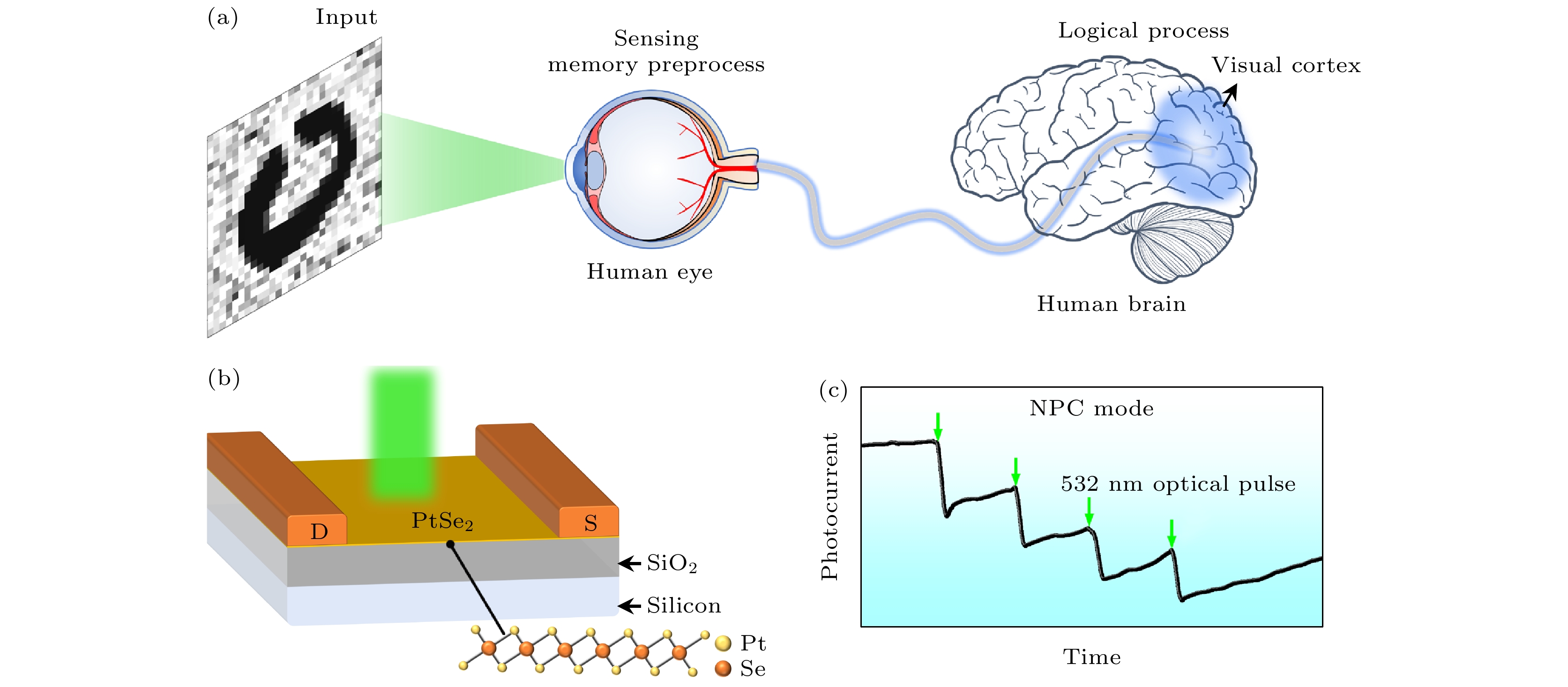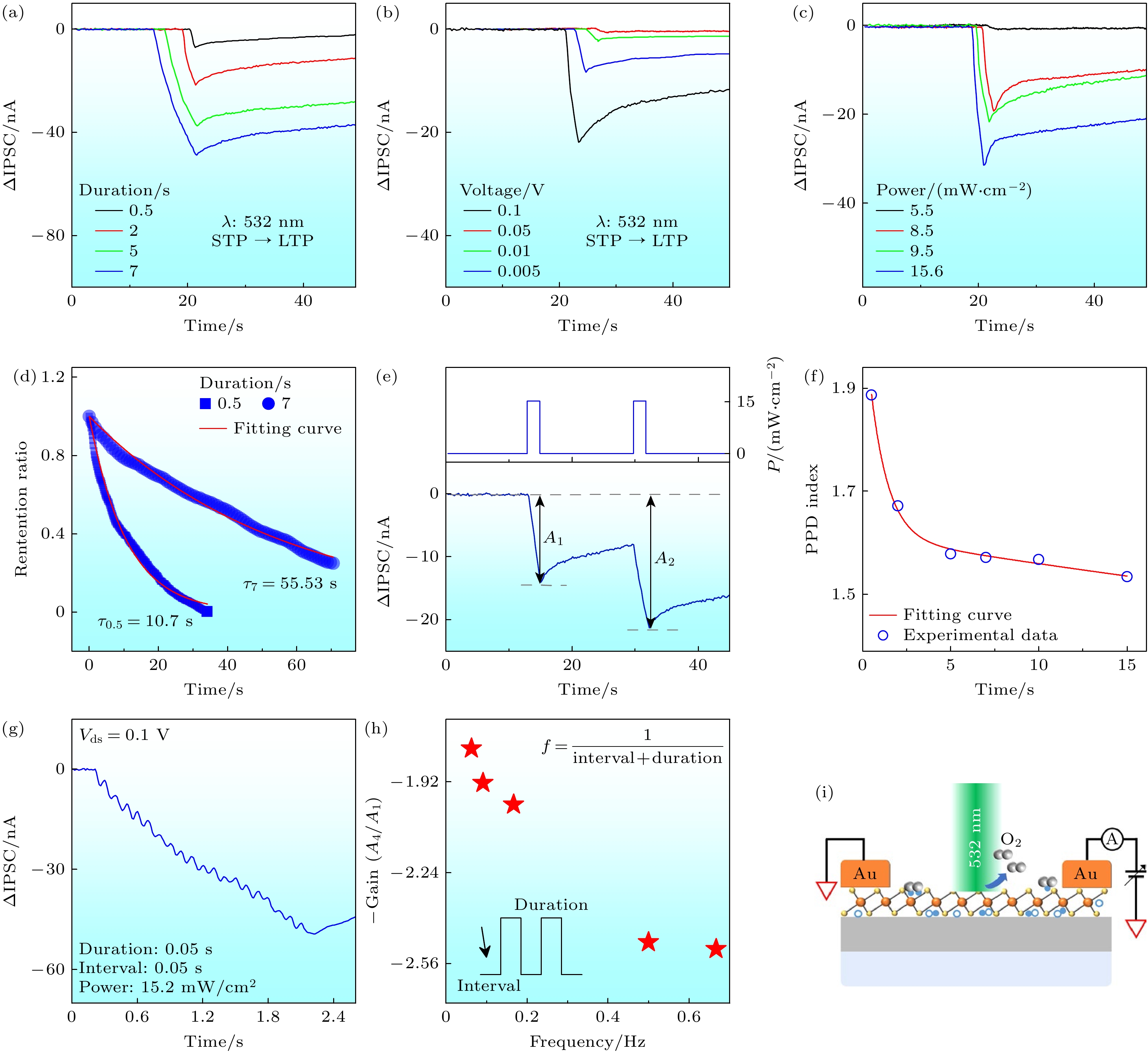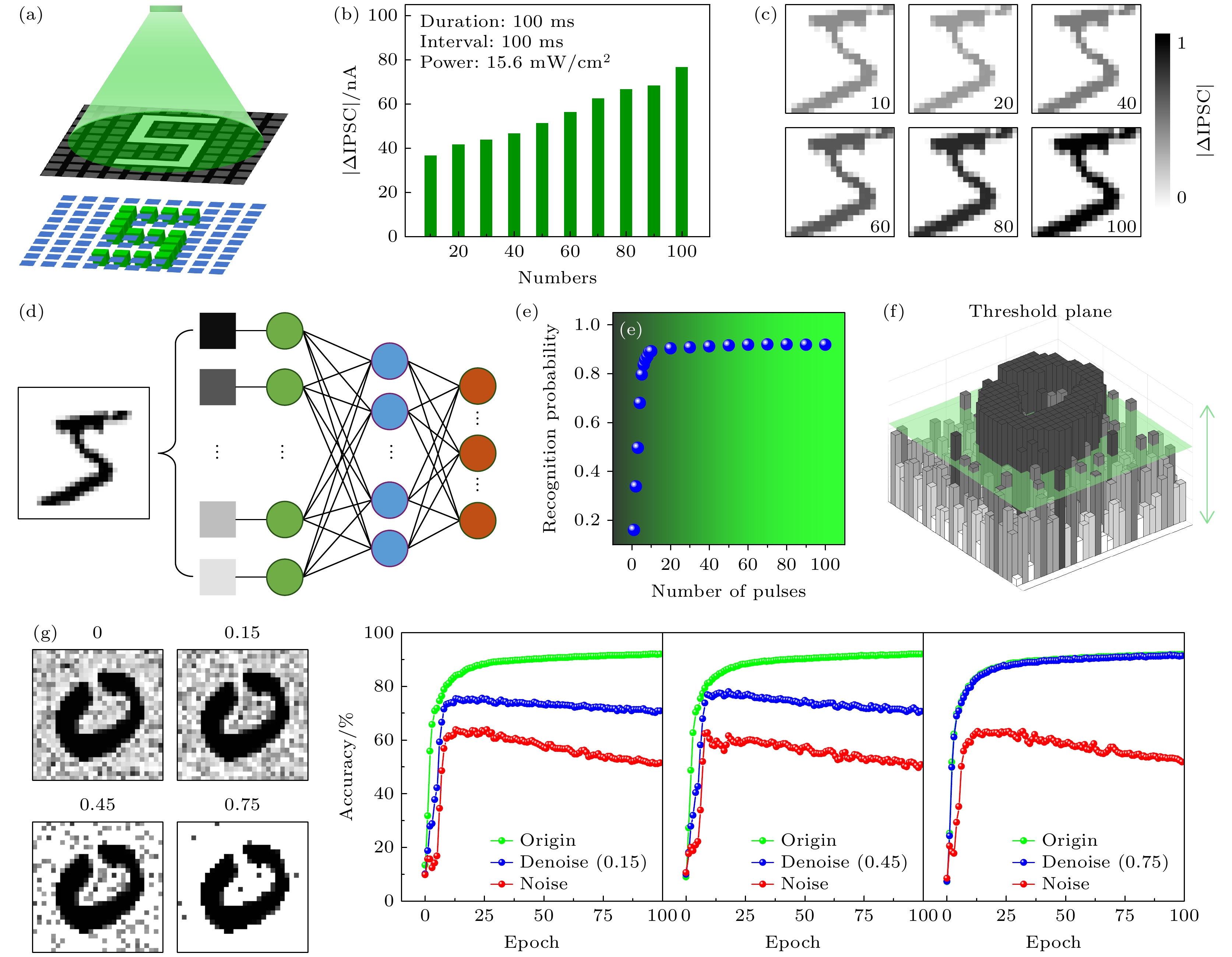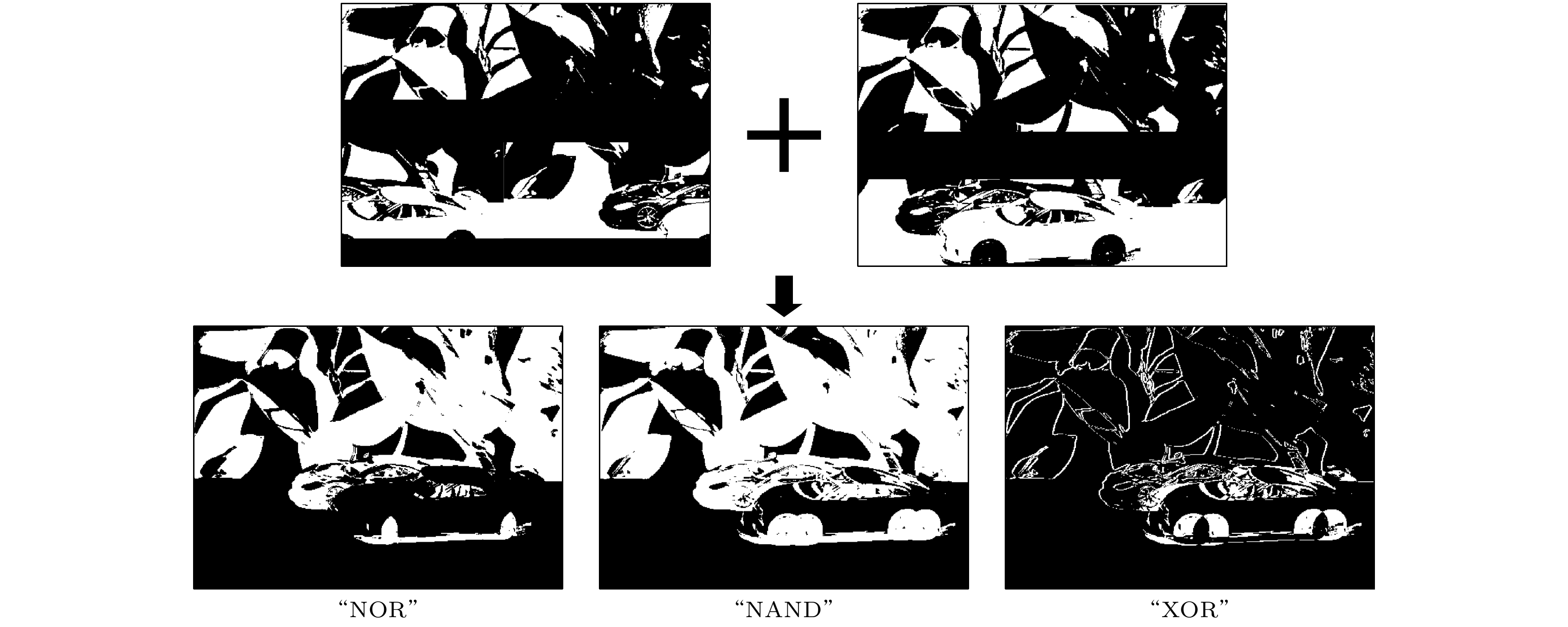-
Machine vision, serving as the “eyes” of artificial intelligence (AI), is one of the key windows for AI to acquire external information. However, traditional machine vision relies on the Von Neumann architecture, where sensing, storage, and processing are separated. This architecture necessitates constant data transfer between different units, inevitably leading to high power consumption and latency. To address these challenges, a PtSe2 photosynaptic device with negative light response is prepared. The device shows an inhibitory postsynaptic current (IPSC) under light pulse stimulation, and achieves optically tunable synaptic behaviors, including double pulse facilitation (PPD), short-range plasticity (STP), and long-range plasticity (LTP). In addition, by using a 3 × 3 sensor array, the device exhibits dependence on light duration, and the image in-situ sensing and storage functions are demonstrated and verified. By using 28 × 28 device array combined with artificial neural network (ANN), the integrated perception-storage-preprocessing function of visual information is realized. The experimental results show that the image after preprocessing (denoising) is trained for 100 epochs, and the accuracy rate reaches 91%. Finally, lasers with two representative wavelengths of 405 nm and 532 nm are chosen as the light sources in the experiment, and the I-V characteristic curve changes most under the blue light pulse of 450 nm, which is because the blue light has higher photon energy to produce negative light effect. Based on the different photocurrents of the device responding to different wavelengths of light, the photoelectric synaptic logic gates ‘NOR’, ‘NAND’ and ‘XOR’ are established, which enables image processing functions such as dilation, erosion and difference recognition. The device’s power consumption is calculated to be 0.111 nJ per spike. The research results indicate that the negative photoconductivity of PtSe2 has great potential in simplifying information processing and effectively promoting applications, which will help promote more integrated and efficient NVS.
-
Keywords:
- PtSe2 /
- negative photoconductivity /
- neuromorphic visual system /
- sensing-storage-computing /
- image logic operation
[1] Zhou F C, Zhou Z, Chen J W, Choy T H, Wang J L, Zhang N, Lin Z Y, Yu S M, Kang J F, Wong H P, Chai Y 2019 Nat. Nanotechnol. 14 776
 Google Scholar
Google Scholar
[2] Mennel L, Symonowicz J, Wachter S, Polyushkin D K, Molina-Mendoza A J, Mueller T 2020 Nature 579 62
 Google Scholar
Google Scholar
[3] Wang G Z, Wang R B, Kong W Z, Zhang J H 2018 Cogn. Neurodynamics 12 615
 Google Scholar
Google Scholar
[4] Wei B, Chen Y B, Han X T, Kang Y, Liang B J, Li C, Yang X K, Liang F, Peng Y X 2025 Sci. China Inf. Sci. 68 140406
 Google Scholar
Google Scholar
[5] Choi C, Leem J, Kim M, Taqieddin A, Cho C, Cho K W, Lee G J, Seung H, Bae H J, Song Y M, Hyeon T, Aluru N R, Nam S, Kim D H 2020 Nat. Commun. 11 5934
 Google Scholar
Google Scholar
[6] Hou Y X, Li Y, Zhang Z C, Li J Q, Qi D H, Chen X D, Wang J J, Yao B W, Yu M X, Lu T B, Zhang J 2020 ACS Nano 15 1497
 Google Scholar
Google Scholar
[7] Chen Y B, Huang Y J, Zeng J W, Kang Y, Tan Y L, Xie X N, Wei B, Li C, Liang F, Jiang T 2023 ACS Appl. Mater. Interfaces 15 58631
 Google Scholar
Google Scholar
[8] Li S Y, Li J T, Zhou K, Yan Y, Ding G L, Han S T, Zhou Y 2024 Phys. Mater. 7 032002
 Google Scholar
Google Scholar
[9] Lian H X, Liao Q F, Yang B D, Zhai Y B, Han S T, Zhou Y 2021 Mater. Chem. C 9 640
 Google Scholar
Google Scholar
[10] 沈柳枫, 胡令祥, 康逢文, 叶羽敏, 诸葛飞 2022 物理学报 71 148505
 Google Scholar
Google Scholar
Shen L F, Hu L X, Kang F W, Ye Y M, Zhuge F 2022 Acta Phys. Sin. 71 148505
 Google Scholar
Google Scholar
[11] Kang Y, Chen Y B, Tan Y L, Hao H, Li C, Xie X N, Hua W H, Jiang T 2023 J. Materiomics 9 787
 Google Scholar
Google Scholar
[12] Lee G, Baek J H, Ren F, Pearton S, Lee G H, Kim J 2021 Small 17 2100640
 Google Scholar
Google Scholar
[13] Sun L F, Wang W, Yang H J 2020 Adv. Intellig. Syst. 2 1900167
 Google Scholar
Google Scholar
[14] Zhao M Y, Hao Y R, Zhang C, Zhai R L, Liu B Q, Liu W C, Wang C 2022 Crystals 12 1087
 Google Scholar
Google Scholar
[15] 李策, 杨栋梁, 孙林锋 2022 物理学报 71 218504
 Google Scholar
Google Scholar
Li C, Yang D L, Sun L F 2022 Acta Phys. Sin. 71 218504
 Google Scholar
Google Scholar
[16] Li Z C, Wang H L, Wang H P, Li J, Qing F Z, Li X S, Xie D, Zhu H W 2024 Nano Res. 16 10189
 Google Scholar
Google Scholar
[17] Wang Y, Liu E F, Gao A Y, Cao T J, Long M S, Pan C, Zhang L L, Zeng J W, Wang C Y, Hu W D, Liang S J, Miao F 2018 ACS Nano 12 9513
 Google Scholar
Google Scholar
[18] Nakanishi H, Bishop K J M, Kowalczyk B, Nitzan A, Weiss E A, Tretiakov K V, Apodaca M M, Klajn R, Stoddart J F, Grzybowski B A 2009 Nature 460 371
 Google Scholar
Google Scholar
[19] Wei P C, Chattopadhyay S, Yang M D, Tong S C, Shen J L, Lu C Y, Shih H C, Chen L C, Chen K H 2010 Phys. Rev. B 81 045306
 Google Scholar
Google Scholar
[20] Ding L W, Liu N S, Li L Y, Wei X, Zhang X H, Su J, Rao J Y, Yang C X, Li W Z, Wang J B, Gu H S, Gao Y H 2015 Adv. Mater. 27 3525
 Google Scholar
Google Scholar
[21] Guo N, Hu W D, Liao L, Yip S P, Ho J C, Miao J S, Zhang Z, Zou J, Jiang T, Wu S W, Chen X S, Lu W 2014 Adv. Mater. 26 8203
 Google Scholar
Google Scholar
[22] Lui C H, Frenzel A J, Pilon D V, Lee Y H, Ling X, Akselrod G M, Kong J, Gedik N 2014 Phys. Rev. Lett. 113 166801
 Google Scholar
Google Scholar
[23] Yang Y M, Peng X Y, Kim H S, Kim T, Jeon S, Kang H K, Choi W, Song J D, Doh Y J, Yu D 2015 Nano Lett. 15 5875
 Google Scholar
Google Scholar
[24] Zhao Y D, Qiao J S, Yu Z H, Yu P, Xu K, Lau S P, Zhou W, Liu Z, Wang X R, Ji W, Chai Y 2017 Adv. Mater. 29 1604230
 Google Scholar
Google Scholar
[25] Hu X, Zhang H M, Liu Y W, Zhang S M, Sun Y Y, Guo Z X, Sheng Y C, Wang X D, Luo C, Wu X, Wang J L, Hu W D, Xu Z H, Sun Q Q, Zhou P, Shi J, Sun Z Z, Zhang D W, Bao W Z 2019 Adv. Funct. Mater. 29 1805614
 Google Scholar
Google Scholar
[26] Choi C, Choi M K, Liu S Y, Kim M, Park O K, Im C, Kim J, Qin X L, Lee G J, Cho K W, Kim M, Joh E, Lee J, Son D, Kwon S H, Jeon N L, Song Y M, Lu N, Kim D H 2017 Nat. Commun. 8 1664
 Google Scholar
Google Scholar
[27] Posch C, Serrano-Gotarredona T, Linares-Barranco B, Delbruck T 2014 Proc. IEEE 102 1470
 Google Scholar
Google Scholar
[28] Luo Z D, Xia X, Yang M M, Wilson N R, Gruverman A, Alexe M 2020 ACS Nano 14 746
 Google Scholar
Google Scholar
[29] Ohno T, Hasegawa T, Tsuruoka T, Terabe K, Gimzewski J K, Aono M 2011 Nat. Mater. 10 591
 Google Scholar
Google Scholar
[30] George A, Fistul M V, Gruenewald M, Kaiser D, Lehnert T, Mupparapu R, Neumann C, Hubner U, Schaal M, Masurkar N, Arava L M R, Staude I, Kaiser U, Fritz T, Turchanin A 2021 npj 2D Mater. Appl. 5 15
[31] Chang T, Jo S H, Lu W 2011 ACS Nano 5 7669
 Google Scholar
Google Scholar
[32] Li D Y, Li C M, Ilyas N, Jiang X D, Liu F C, Gu D E, Xu M, Jiang Y D, Li W 2020 Adv. Intelligent Syst. 2 2000107
 Google Scholar
Google Scholar
[33] de Ronde W, ten Wolde P R, Mugler A 2012 Biophys. J. 103 1097
[34] Deng Y, Liu S H, Ma X X, Guo S Y, Zhai B X, Zhang Z H, Li M S, Yu Y M, Hu W H, Yang H, Kapitonov Y, Han J B, Wu J S, Li Y, Zhai T Y 2024 Adv. Mater. 36 230940
 Google Scholar
Google Scholar
[35] Sun Y L, Qian L, Xie D, Lin Y X, Sun M X, Li W W, Ding L M, Ren T L, Palacios T 2019 Adv. Funct. Mater. 29 1902538
 Google Scholar
Google Scholar
[36] Abnavi A, Ahmadi R, Hasani A, Fawzy M, Mohammadzadeh M R, De Silva T, Yu N N, Adachi M M 2021 ACS Appl. Mater. Interfaces 13 45843
 Google Scholar
Google Scholar
[37] Wang W X, Gao S, Li Y, Yue W J, Kan H, Zhang C W, Lou Z, Wang L L, Shen G Z 2021 Adv. Funct. Mater. 31 2101201
 Google Scholar
Google Scholar
-
图 3 PtSe2光电突触的ΔIPSC响应与光刺激 (a)持续时间; (b)光强; (c)读取电压的关系; (d)记忆保持特性曲线; (e)两个连续的光脉冲诱导的IPSC; (f) PPD 指数与脉冲间隔之间的关系; (g) ΔIPSC在20个绿光脉冲下的光响应; (h)增益(A4/A1)与频率的关系; (i) NPC机理示意图
Figure 3. ΔIPSC response and light stimulation of PtSe2 photoelectric synapse: (a) Light duration time; (b) light intensity; (c) reading voltage; (d) curve of memory retention ratio; (e) the ΔIPSC triggered by two consecutive light pulses; (f) PPD index as a function of the interval of light pulse pairs; (g) ΔIPSC response under 20 green light pulses; (h) relationship between gain (A4/A1) and frequency; (i) schematic diagram of the NPC mechanism.
图 5 (a)将图像“5”映射到突触阵列的掩膜方法示意图; (b) |∆IPSC|与脉冲数目的关系; (c)数字目标增强; (d)人工神经网络(ANN); (e)图像识别结果与光脉冲数量的关系; (f) NVS中的图像去噪; (g)不同数据集上识别准确性的比较
Figure 5. (a) Schematic diagram of the mask method for mapping the image ‘5’ to the synaptic array; (b) statistical information on the relationship between |∆IPSC| and pulse number; (c) number recognition enhancement; (d) an artificial neural network (ANN) for processing image data; (e) relationship between image recognition results and the number of optical pulses; (f) image denoising in NVS; (g) comparisons of the recognition accuracy on different datasets.
表 1 PtSe2光电突触的结构与性能与近几年报道的光电突触的对比
Table 1. Device structure and performance of some reported photonic artificial synapses.
-
[1] Zhou F C, Zhou Z, Chen J W, Choy T H, Wang J L, Zhang N, Lin Z Y, Yu S M, Kang J F, Wong H P, Chai Y 2019 Nat. Nanotechnol. 14 776
 Google Scholar
Google Scholar
[2] Mennel L, Symonowicz J, Wachter S, Polyushkin D K, Molina-Mendoza A J, Mueller T 2020 Nature 579 62
 Google Scholar
Google Scholar
[3] Wang G Z, Wang R B, Kong W Z, Zhang J H 2018 Cogn. Neurodynamics 12 615
 Google Scholar
Google Scholar
[4] Wei B, Chen Y B, Han X T, Kang Y, Liang B J, Li C, Yang X K, Liang F, Peng Y X 2025 Sci. China Inf. Sci. 68 140406
 Google Scholar
Google Scholar
[5] Choi C, Leem J, Kim M, Taqieddin A, Cho C, Cho K W, Lee G J, Seung H, Bae H J, Song Y M, Hyeon T, Aluru N R, Nam S, Kim D H 2020 Nat. Commun. 11 5934
 Google Scholar
Google Scholar
[6] Hou Y X, Li Y, Zhang Z C, Li J Q, Qi D H, Chen X D, Wang J J, Yao B W, Yu M X, Lu T B, Zhang J 2020 ACS Nano 15 1497
 Google Scholar
Google Scholar
[7] Chen Y B, Huang Y J, Zeng J W, Kang Y, Tan Y L, Xie X N, Wei B, Li C, Liang F, Jiang T 2023 ACS Appl. Mater. Interfaces 15 58631
 Google Scholar
Google Scholar
[8] Li S Y, Li J T, Zhou K, Yan Y, Ding G L, Han S T, Zhou Y 2024 Phys. Mater. 7 032002
 Google Scholar
Google Scholar
[9] Lian H X, Liao Q F, Yang B D, Zhai Y B, Han S T, Zhou Y 2021 Mater. Chem. C 9 640
 Google Scholar
Google Scholar
[10] 沈柳枫, 胡令祥, 康逢文, 叶羽敏, 诸葛飞 2022 物理学报 71 148505
 Google Scholar
Google Scholar
Shen L F, Hu L X, Kang F W, Ye Y M, Zhuge F 2022 Acta Phys. Sin. 71 148505
 Google Scholar
Google Scholar
[11] Kang Y, Chen Y B, Tan Y L, Hao H, Li C, Xie X N, Hua W H, Jiang T 2023 J. Materiomics 9 787
 Google Scholar
Google Scholar
[12] Lee G, Baek J H, Ren F, Pearton S, Lee G H, Kim J 2021 Small 17 2100640
 Google Scholar
Google Scholar
[13] Sun L F, Wang W, Yang H J 2020 Adv. Intellig. Syst. 2 1900167
 Google Scholar
Google Scholar
[14] Zhao M Y, Hao Y R, Zhang C, Zhai R L, Liu B Q, Liu W C, Wang C 2022 Crystals 12 1087
 Google Scholar
Google Scholar
[15] 李策, 杨栋梁, 孙林锋 2022 物理学报 71 218504
 Google Scholar
Google Scholar
Li C, Yang D L, Sun L F 2022 Acta Phys. Sin. 71 218504
 Google Scholar
Google Scholar
[16] Li Z C, Wang H L, Wang H P, Li J, Qing F Z, Li X S, Xie D, Zhu H W 2024 Nano Res. 16 10189
 Google Scholar
Google Scholar
[17] Wang Y, Liu E F, Gao A Y, Cao T J, Long M S, Pan C, Zhang L L, Zeng J W, Wang C Y, Hu W D, Liang S J, Miao F 2018 ACS Nano 12 9513
 Google Scholar
Google Scholar
[18] Nakanishi H, Bishop K J M, Kowalczyk B, Nitzan A, Weiss E A, Tretiakov K V, Apodaca M M, Klajn R, Stoddart J F, Grzybowski B A 2009 Nature 460 371
 Google Scholar
Google Scholar
[19] Wei P C, Chattopadhyay S, Yang M D, Tong S C, Shen J L, Lu C Y, Shih H C, Chen L C, Chen K H 2010 Phys. Rev. B 81 045306
 Google Scholar
Google Scholar
[20] Ding L W, Liu N S, Li L Y, Wei X, Zhang X H, Su J, Rao J Y, Yang C X, Li W Z, Wang J B, Gu H S, Gao Y H 2015 Adv. Mater. 27 3525
 Google Scholar
Google Scholar
[21] Guo N, Hu W D, Liao L, Yip S P, Ho J C, Miao J S, Zhang Z, Zou J, Jiang T, Wu S W, Chen X S, Lu W 2014 Adv. Mater. 26 8203
 Google Scholar
Google Scholar
[22] Lui C H, Frenzel A J, Pilon D V, Lee Y H, Ling X, Akselrod G M, Kong J, Gedik N 2014 Phys. Rev. Lett. 113 166801
 Google Scholar
Google Scholar
[23] Yang Y M, Peng X Y, Kim H S, Kim T, Jeon S, Kang H K, Choi W, Song J D, Doh Y J, Yu D 2015 Nano Lett. 15 5875
 Google Scholar
Google Scholar
[24] Zhao Y D, Qiao J S, Yu Z H, Yu P, Xu K, Lau S P, Zhou W, Liu Z, Wang X R, Ji W, Chai Y 2017 Adv. Mater. 29 1604230
 Google Scholar
Google Scholar
[25] Hu X, Zhang H M, Liu Y W, Zhang S M, Sun Y Y, Guo Z X, Sheng Y C, Wang X D, Luo C, Wu X, Wang J L, Hu W D, Xu Z H, Sun Q Q, Zhou P, Shi J, Sun Z Z, Zhang D W, Bao W Z 2019 Adv. Funct. Mater. 29 1805614
 Google Scholar
Google Scholar
[26] Choi C, Choi M K, Liu S Y, Kim M, Park O K, Im C, Kim J, Qin X L, Lee G J, Cho K W, Kim M, Joh E, Lee J, Son D, Kwon S H, Jeon N L, Song Y M, Lu N, Kim D H 2017 Nat. Commun. 8 1664
 Google Scholar
Google Scholar
[27] Posch C, Serrano-Gotarredona T, Linares-Barranco B, Delbruck T 2014 Proc. IEEE 102 1470
 Google Scholar
Google Scholar
[28] Luo Z D, Xia X, Yang M M, Wilson N R, Gruverman A, Alexe M 2020 ACS Nano 14 746
 Google Scholar
Google Scholar
[29] Ohno T, Hasegawa T, Tsuruoka T, Terabe K, Gimzewski J K, Aono M 2011 Nat. Mater. 10 591
 Google Scholar
Google Scholar
[30] George A, Fistul M V, Gruenewald M, Kaiser D, Lehnert T, Mupparapu R, Neumann C, Hubner U, Schaal M, Masurkar N, Arava L M R, Staude I, Kaiser U, Fritz T, Turchanin A 2021 npj 2D Mater. Appl. 5 15
[31] Chang T, Jo S H, Lu W 2011 ACS Nano 5 7669
 Google Scholar
Google Scholar
[32] Li D Y, Li C M, Ilyas N, Jiang X D, Liu F C, Gu D E, Xu M, Jiang Y D, Li W 2020 Adv. Intelligent Syst. 2 2000107
 Google Scholar
Google Scholar
[33] de Ronde W, ten Wolde P R, Mugler A 2012 Biophys. J. 103 1097
[34] Deng Y, Liu S H, Ma X X, Guo S Y, Zhai B X, Zhang Z H, Li M S, Yu Y M, Hu W H, Yang H, Kapitonov Y, Han J B, Wu J S, Li Y, Zhai T Y 2024 Adv. Mater. 36 230940
 Google Scholar
Google Scholar
[35] Sun Y L, Qian L, Xie D, Lin Y X, Sun M X, Li W W, Ding L M, Ren T L, Palacios T 2019 Adv. Funct. Mater. 29 1902538
 Google Scholar
Google Scholar
[36] Abnavi A, Ahmadi R, Hasani A, Fawzy M, Mohammadzadeh M R, De Silva T, Yu N N, Adachi M M 2021 ACS Appl. Mater. Interfaces 13 45843
 Google Scholar
Google Scholar
[37] Wang W X, Gao S, Li Y, Yue W J, Kan H, Zhang C W, Lou Z, Wang L L, Shen G Z 2021 Adv. Funct. Mater. 31 2101201
 Google Scholar
Google Scholar
Catalog
Metrics
- Abstract views: 1895
- PDF Downloads: 55
- Cited By: 0














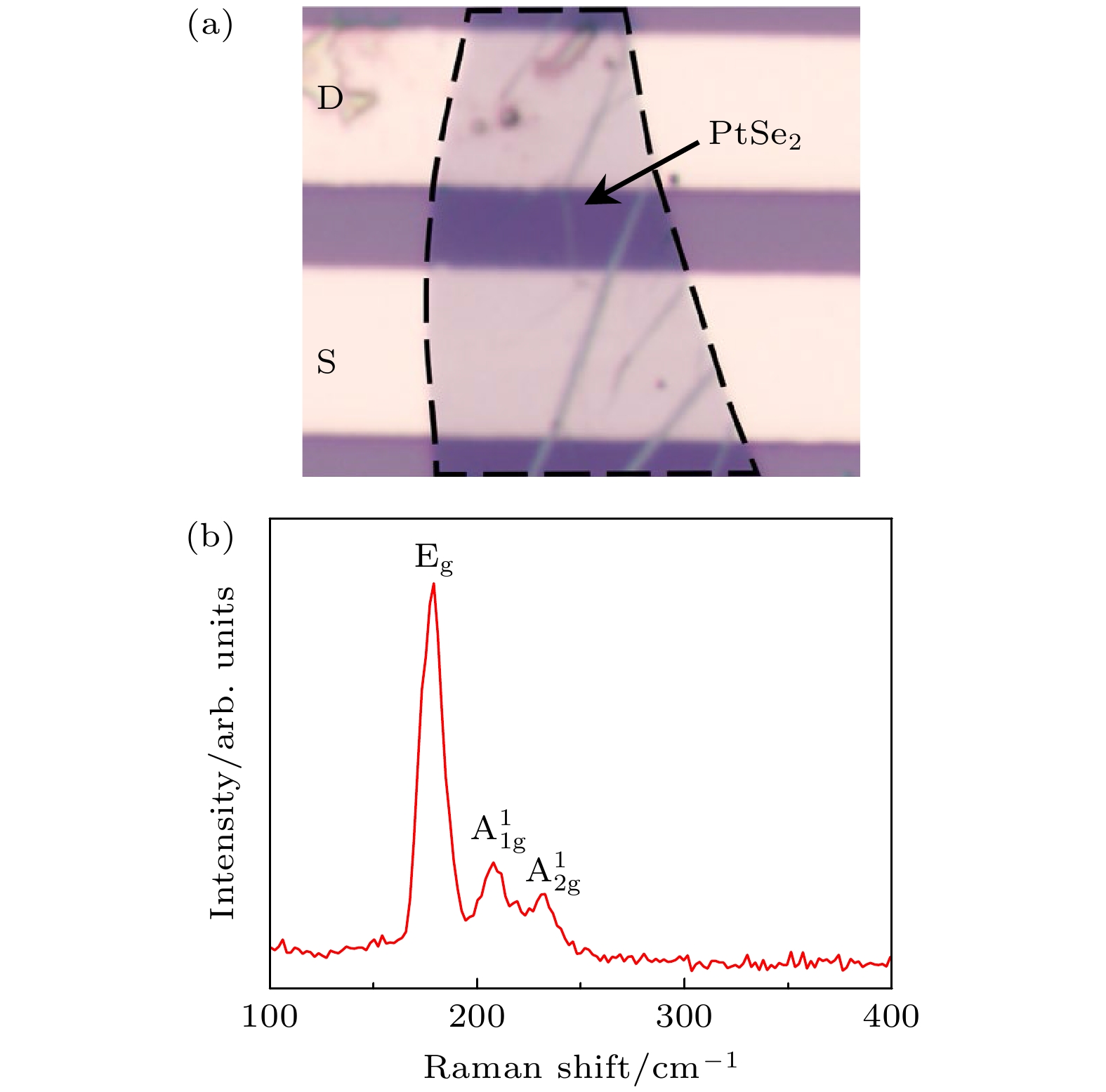
 DownLoad:
DownLoad:
